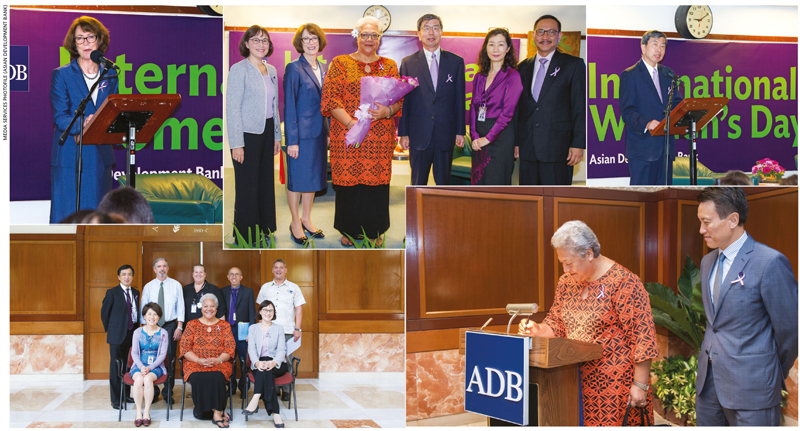THE GLASS CEILING
BRIDGING THE GENDER GAP
Yamini Sequeira highlights the need to improve gender parity in the public and private sectors
The Asian Development Bank (ADB) conducted a customary ‘Gender Month’ as part of its annual tradition in March to reaffirm its ongoing commitment to gender equality and women’s empowerment in the Asia-Pacific region.
As part of the celebrations, Helen Clark – a former administrator at the UNDP – shared her thoughts on the future of women’s leadership. Prior to becoming the first woman to lead the UNDP, Clark served for nine years as the first woman Prime Minister of New Zealand. She is also a member of the Council of Women World Leaders.
Clark’s insights on bridging the gender gap ranged from what works well to create an enabling environment for female leadership and the future of women (and men) who are seeking to make a difference by championing gender equality.
“Despite much progress in many places, many glass ceilings remain and women in leadership positions globally are still a rare commodity,” she observed.
She also pointed out that global economic gains from reducing gender inequality are considerable – projected to be an estimated US$ 5.3 trillion by 2025 even with only a 25 percent reduction in the gender gap.
“If the full contribution of women to economies and societies isn’t realised, it’s not only women who won’t reach their full potential; whole countries won’t reach their full potential,” Clark emphasised.
The number of women in positions of leadership around the planet is very low. Women make up only 7.2 percent of heads of state, 5.7 percent of heads of government, 23.3 per cent of parliamentarians and around 20 percent of Fortune 500 company board members. Only about 15 percent of women are corporate board members, according to surveys by Credit Suisse of some 3,000 global companies. And they occupy less than a quarter of senior management positions in the private sector.
Clark drove home the fact that in the corporate world, study after study has found that companies with more women on their boards derive much better financial results.
She elaborated: “There are proactive steps we can take to grow the numbers of women in leadership; but we also need to ensure that women are more fairly represented across all levels of the economic, social, and political organisation of societies. Getting into leadership positions normally involves a progression up the ranks but women may find it difficult to get on the first rung of the ladder and when they do, they may find that some rungs are missing…”
In developing Asia, only 49 percent of women of working age participate in the labour force compared with 80 percent of men. Further, a woman in developing Asia is paid only about 75 percent of the wages of her male counterpart. Only about 10 percent of women in the region own land, which makes it difficult for them to borrow money to start a business of their own.
The region also has far to go in terms of reaching gender parity in the boardroom as well as in legislative bodies – women occupy only six percent of seats on corporate boards and about 18 percent of seats in legislatures across Asia-Pacific. These and other disparities must be eliminated for the region to reach its full potential.
As for Sri Lanka, a Chapter on Women’s Rights has been included in the National Human Rights Action Plan (2017-2021) to address issues such as law reform, war affected women, employment and enhancing institutional mechanisms. According to the UNDP’s Human Development Report 2014, Sri Lanka ranked 73rd among 187 countries in the Human Development Index (HDI) in 2013 with an HDI of 0.75 and an inequality adjusted HDI of 0.643.
The same report ranked the island nation – the first to elect a woman prime minister – as 75th in the Gender Inequality Index (GII) with a GII of 0.383. The GII measures inequality between women and men in three dimensions: reproductive health, empowerment (political participation and education) and labour market participation. A GII of 0.383 indicates that gender inequality along these three dimensions is low in Sri Lanka.
Meanwhile, the World Bank notes that in Sri Lanka the questions that remain include not merely how to make the workplace more inviting to women but also increase the number of women in employment.
Gender discrimination at every step of employment – from job searches and headhunting, to actual hiring and promotion – is a reality that many women face. At home, gender once again determines who bears the burden of being the primary caregiver and is essentially responsible for household work.
Studies reveal that unlike for men, marriage serves as a major deterrent to women’s chances of participating in labour markets. “It is clear that gender equality needs to start with the family and to start in the home,” says World Bank Country Director for Sri Lanka and the Maldives Dr. Idah Pswarayi-Riddihough, adding. “We should ask ourselves as women, why we don’t do more to break the barriers? Why we continue to fit into a mould we don’t like?”
We should ask ourselves as women, why we don’t do more to break the barriers? Why we continue to fit into a mould we don’t like?






A recommendation could be allowing more women to take up as entrepreneurs and start businesses to shatter this ugly glass ceiling. Having women spearheading the top tier is a fast track and workable idea to break the glass ceiling. Female driven leadership in which women head the top level is also a good method to break the glass ceiling.
The top-down approach is more sustainable than the bottom-up approach as the latter remains at a standstill and makes the female workforce stagnant. The glass ceiling holds the female workforce down from the West to East, ranging from traditional to cosmopolitan cultures.
Some East Asian economies are performing against this norm. These nations saw the importance of female employees who can create wealth rather than profits in the long-term. These economies felt the need to minimise the risk arising from the aging workforce. Hence, such nations have reshaped their strategic outlook enabling many flexible options to potentially re-attract and encourage females to join the workforce.
A fragile glass ceiling that makes businesses and nations more agile makes me glad.
The female workforce – including skilled workers and professionals – encounters threats from both male and female counterparts, in addition to a lack of determination in females to break barriers to cross boundaries.
There is a dual burden on the part of female employees as male counterparts too are ‘glass ceiling’ culprits. In many cases, female employees being perceived as useless (inferior) and less valuable than men (inequity) are some of those negative perceptions that keep the female workforce from rejoining employment or breaking barriers.
More than men, a few queen bees can create hell at the workplace for women employees. ‘Queen bee syndrome’ is a classic example – where the females who manage to get to the top tiers become more mean to their own gender rather than to the opposite gender. The female employees are treated in an inhuman way. Studies reveal that as the queen bee has gone through the harsh way to advance in her career, she expects other female workers to be treated in the same way with a ‘why not’ attitude.
More culprits and blockers than saviours question whether the glass ceiling is a commodity without which the world cannot exist. Only if prayers are answered may the glass ceiling be abolished.